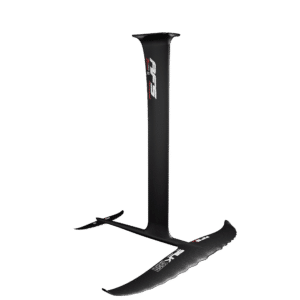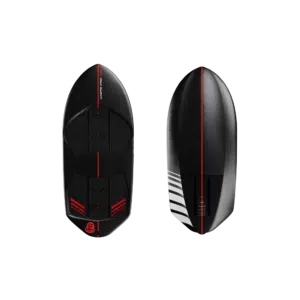Panier
Close
- No products in the cart.
Sous total (Hors frais de livraison)
0,00€
Surf foil experts: our brand offers top-of-the-range equipment, sound advice and French carbon production for optimum performance.
Surf foil may sound crazy to you, but it’s a reality. It provides sensations that are just crazy!
Take up foil surfing: everything you need to know in this article
Foil surfing is a nautical activity that combines traditional surfing with the use of a hydrofoil, enabling the board to rise and ride a breaking wave, while flying above the surface of the water. Today, with the arrival of more accessible equipment, such as beginners’ packs, the discipline has spread to a large number of riders. Whether you’re looking for second-hand equipment or a top-of-the-range carbon model, there’s a selection to suit all levels.
Why surf foil?
Surfing in all conditions
Even when the weather’s not cooperating, foil surfing allows you to glide along and have fun. A small swell is all it takes to have fun, especially with a well-shaped and adapted board. You’ll be able to save sessions you would have missed with classic surfing. It’s also ideal for improving your pumping skills!
Experience the ocean differently
With part of the foil underwater, you feel every micro-wave. This intense connection with natural elements like water is unique, quite different from the sensations of a stand-up paddle or classic surfboard. Gliding becomes fluid and intuitive.
Surf longer
In foil surfing, you can link waves together thanks to pumping. Good technique and a little cardio are all you need to fly from wave to wave without stopping. This is where choosing an ultra-rigid mast and a quality foil makes all the difference.
Complementarity with other board sports
Surf foil is an excellent complement to wing foil, windfoil, kite foil or even stand-up paddle. You learn to manage lift, stance (your position on the board) and pumping, which helps you progress in all disciplines.
How do surf foils work?
A surf foil consists of a front wing, a stab, a fuselage, a mast and a plate attachment between the board and the foil. For it to work, you need to obtain speed (via a natural wave or one generated by a boat), then create an angle of incidence by pressing on your back foot. The front wing then generates lift and launches the board. If you want to descend, you put weight on the front; to regain height, you press on the tail again. Once airborne, the foil becomes sensitive, so a rigid carbon foil is highly recommended.
It takes a little practice at first to maintain stable flight; but once you get the hang of it, it’s an incredible feeling.
How do I start foiling?
For the take-off in foil surfing, we tend to use surfing reflexes, i.e. putting the board back askew. Unfortunately, this doesn’t work in foil surfing. Our advice is to concentrate on the take-off, catching the wave facing the beach and perpendicular to the undulation. In fact, you can start with just the mosses. The foil will then try to take off like an airplane wing. When you do your take-off, to straighten up you’re going to have to stand up with your front foot, and maybe even exaggerate by putting it further forward than usual. Indeed, you’re right in the middle of the propulsive force. This will create maximum lift.
Not having the usual surfer’s stance is normal. For beginners, having the front foot much further apart than normal is common and will enable you to control your foil well.
Choosing the right foil surfing equipment
The front wing
For beginners, we recommend a front wing with a size of around 1000 cm2 (perhaps with a thicker profile for more lift at take-off). Our AFS brand offers a suitable range, with several foils available. The Silk model, for example, is a very good choice in a complete package. It’s a foil dedicated 100% to waveriding. The Enduro model is also a great choice, especially for pumping back to the next wave.
You can easily compare prices on our website.
The stabilizer
It stabilizes or energizes your glide. Opt for a small span for greater liveliness, or a large span for greater stability.
The foil mast for surfing
An ultra-stiff mast is recommended for greater control (UHM or HM at AFS). To ride a wave from the shore, prefer a short mast (75 or 80 cm). And for surfing swells further offshore, a long mast is ideal (85 cm minimum).
The fuselage
It should be short for better handling (small waves); long for greater stability at high speed, perfect for surfing big waves. Ultimately, the choice depends on the type of wave and your style.
Which foil surfboard to choose?
The board’s shape and rigid construction influence how easy it is to take off. A relatively large board (around 40 L) will help you progress more quickly. As for length, just under 5 feet is ideal for learning to pounce: the Chipri pro is AFS’s benchmark model. However, we’ve also designed an ultra-versatile hybrid board, with more volume and size, that could help you surf small waves and get started with foil surfing: the Blackbird mid length in 5’6.
How do I start foiling?
Take off and foot placement
Unlike surfing, you have to start off facing the beach, without immediately putting your board askew once the wave starts to push you. In foiling, you want to take off straight, like an airplane. Put your front foot well forward, even exaggeratedly forward, to maximize lift. Don’t be afraid to break your surfing habits.
Spotlight selection
Start out in easy conditions: soft waves or moss, with few people. Or behind the trailing wave of a boat, where you’ll understand the glide better. Above all, avoid shore breaks. What’s important is a long, deep wave, so you can learn without danger.
First flights and reflexes
In foiling, there’s a golden rule: never force against the foil’s movement. If you’re aiming left but the foil has decided to go right, the surfer’s classic reflex would be to push hard to get the board back on axis. Not a good idea with foils! If you try to counter, you risk accentuating the unintended trajectory, often resulting in a violent fall. The right reflex? Let go and throw yourself on the opposite side of the foil. This is one of the most important safety tips to remember.
Once in the air, with good foot placement, clear eyes and well-positioned arms swinging, you can start working on your curves. Carving foils is like surfing: everything starts from the head. You look where you want to go, open your shoulders, follow with your arms, and the rest of your body follows naturally. But be careful: here, the margin for error is very small. You have to be precise, light in your movements, and above all avoid sudden movements that could land you…directly on the foil.
As for pumping up to the peak once you’ve surfed the first wave, once again you’ll need to use your legs as well as your arms: the idea is to be light and fluid, not to force yourself. Let the foil rise naturally, then come back down. In concrete terms, you need to push with your back leg to pitch the board up, then shift your weight to your front leg to generate lift and stay airborne, or even take off again if you hit the water.
It’s very different from traditional surfing, where you go up, lighten up, then go down into the wave, forcing yourself. In pumping foil, the logic is more subtle: you pump, you glide, you lighten up, you glide again… a precise sequence that requires technique and a good cardio. But it allows you to ride wave after wave without limit.
Where can I get more information?
Numerous brands, surf shops and influencers regularly offer videos, product tests and tutorials to help you learn to ride safely. And on our website, you’ll find all the information you need on foil surfing, whether you’re looking to buy online, buy second-hand equipment or get some teaching tips. Surf foil isn’t just for the elite. With a little curiosity, the right package, board and foil, you can soon be surfing and flying above the water.
Showing all 3 results


